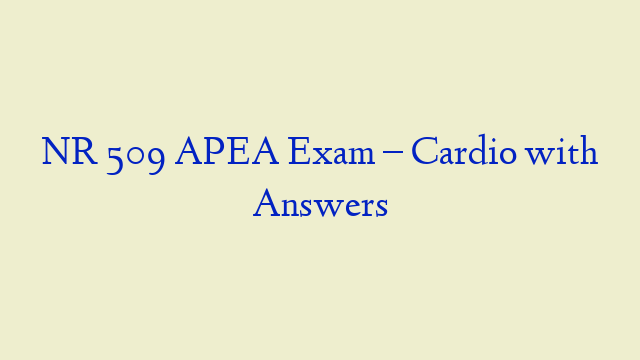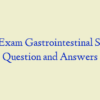Description
NR 509 APEA Exam CARDIO – Question and Answers with Explanations
- The lymphatic ducts drain into the:
- While auscultating the patient’s heart, a medium, soft murmur is audible. It is pansystolic and heard loudest at the apex with radiation to the left axilla. These findings are consistent with:
- Which of the following group of symptoms would be suggestive of an infant experiencing a congenital heart defect associated with a decreased pulmonary blood flow pattern?
- Right atrial pressure can be determined by:
- When assessing the heart rate of a healthy 13-month-old child, which one of the following sites is the most appropriate for this child?
- The infraorbital or maxillary, buccinator, and submandibular lymph nodes drain lymphatic fluid from the:
- The external iliac lymph nodes drain lymphatic fluid from the following areas except the:
- The amplitude of the pulse in a patient in cardiogenic shock would most likely appear:
- When auscultating the heart for aortic insufficiency, ask the patient to:
- The horizontal superficial inguinal lymph nodes are located in the anterior thigh below the inguinal ligament and drain lymphatic fluid from all of these areas except:
- When auscultating the point of maximal impulse (PMI), apex of the heart, in an adult, the stethoscope is placed at the:
- Deep cervical lymph nodes drain lymphatic fluid from the:
- Which of the following symptoms would necessitate the need for further evaluation in the newborn?
- Symptoms of acrocyanosis in the newborn include:
- A heart rate of 100-180 beats per minute in an adult is …..
- Tissue ischemia is usually …..when assessing a patient with peripheral artery disease (PAD). What other symptoms could be …….?
- When performing a cardiovascular assessment on a healthy 2-year-old child:
- A disparity between the brachial and femoral pulses in a 4-month-old could indicate:
- The right lymph duct drains lymphatic fluid from all the following areas except the:
- When auscultating the apex of the heart in an 8-year-old, the bell of the stethoscope should be placed at the:
- In order to assess for varicosities in the lower extremities, position the patient:
- A patient complains of a tight, bursting pain in the calf that increases with walking. The elevation of the leg sometimes relieves the pain. These symptoms may be consistent with:
- Symptoms of orthostatic hypotension include all of the following except:
- A three-week-old infant presents with a generalized lacy, reticulated blue discoloration of the skin. This is suggestive of:
- The supraclavicular lymph nodes are located:
- In an adult patient, auscultate the sounds arising from the mitral valve by placing the stethoscope:The tonsillar lymph node is located:
- A bruit heard in the epigastric area with both systolic and diastolic components is suggestive of:
- The presence of a heart murmur in a child would be considered organic if the child:
- A patient complaints of a sharp, knife-like pain that begins in the chest and radiates to the tip of the shoulder and to the neck. This type of chest pain is suggestive of:
- In order to bring the ventricular apex closer to the chest wall when assessing the point of maximal impulse (PMI), ask the patient to:
- The preauricular lymph node is located:
- To auscultate the heart sounds arising from the pulmonic valve in an adult patient, place the stethoscope:
- To assess aortic pulsations in patients with carotid obstruction, assess the pulse using the:
- When screening a patient for peripheral arterial disease (PAD), one risk factor would include a history of:
- The preauricular nodes drain lymphatic fluid from the:
- The ankle-brachial index is a screening test used to assess a person’s risk for:
- The internal iliac lymph nodes drain lymphatic fluid from the:
- Causes of orthostatic hypotension in older adults may include all of the following except:
- A 5-year-old child presents with complaints of fever and headache. Examination reveals a heart rate of 157 beats/minute, respiratory rate of 40 breaths/minute, B/P 108/54, and a temperature of 102.6 °F. The increased heart rate is most likely related to:
- The posterior chest wall and portions of the arms are ……by which group of lymph nodes?
- A patient states that the only way he can sleep at night is to use several pillows or to sleep upright in a recliner. This sleep pattern is most consistent with:
- A disease that may present as indigestion, but is precipitated by exertion and ….by rest is most likely:
- A patient …..of having chronic venous insufficiency, may present with:
- The great saphenous vein enters the deep venous system by way of the:
- Warning signs of peripheral artery disease may include all of the following except:
- On assessment, which one of the following symptoms would be noted as a compensatory response to chronic hypoxia?
- A patient complains of some pain in the distal portions of her fingers on both hands. She states that it tends to occur more frequently with exposure to cold. These symptoms may be consistent with:
- The patient has had an internal pacemaker in place for five years. Pacemaker failure is being considered because over the past few days, the patient has been experiencing episodes of:
- The thoracic lymph duct drains lymphatic fluid from all the following areas except the:
- When auscultating the heart, the displacement of the point of maximal impulse (PMI) is greater than 10 cm lateral to the midsternal line. This finding is consistent with:
- A sudden, tearing, sharp pain that begins in the chest and radiates to the back or into the neck is usually ……:
- By placing the ball of the examiner’s hand firmly on the chest, the examiner would be checking for:
- Which lymph nodes receive lymphatic fluid from the stomach, duodenum, liver, gallbladder, and pancreas?
- When auscultating the heart of a 55-year-old patient, a loud murmur with a thrill is audible in the right second intercostal space that radiates to the carotid arteries. Also noted is a crescendo-decrescendo pitch audible at the apex. The murmur is heard best with the patient sitting and leaning forward. This finding is consistent with:
- When auscultating heart sounds arising from the aortic valve in an adult patient, place the stethoscope:
- A patient describes chest pain as persistent, sharp, and knife-like. These symptoms are more characteristic of:
- A third heart sound (S3) is audible in a forty-five-year old. This S3 sound may be:
- Enlarged or tender lymph nodes are most often ……:
- A widened pulse pressure greater than or equal to 60 in an older patient is a risk factor for cardiovascular disease, stroke, and:
- Characteristic symptoms of chronic venous insufficiency may include which one of the following?
- Widened pulse pressure (PP) is defined as systolic blood pressure (SBP):
- Characteristic symptoms of chronic arterial insufficiency may include which one of the following?
- Pain or cramping of the legs that occurs during exertion and is ……by rest is ……:
- In older adults, the presence of heart sound S3 suggests:
- To auscultate the tricuspid valve heart sounds in an adult patient, place the stethoscope:
- When auscultating the heart of a 50-year-old patient, a soft murmur is audible in the left second and third intercostal spaces and radiates to the left shoulder and neck. Also noted is a crescendo-decrescendo pitch to the murmur. This finding could be consistent with:
- The hemodynamic changes resulting from structural defects in children can lead to heart failure. The most common reason for these changes is related to:
- The posterior auricular lymph nodes drain lymphatic fluid from the:
- While examining the heart, a pansystolic, blowing murmur is audible over the left sternal border with radiation to the right of the sternum. The intensity increased with inspiration. This finding is characteristic of:
- The axillary lymph nodes drain lymphatic fluid from all of the following areas except the:
- A patient complains of pain in the arch of the foot sometimes relieved by rest. Occasionally, he experiences intermittent pain in the toes, especially at rest. Exercise aggravates the pain in the arch. History reveals he smokes approximately a half pack of cigarettes per day. These symptoms may be consistent with nr 509 apea exam
- The occipital lymph node is located:
- A patient presents with chest pain that radiates to the left side of the neck and down the left arm when he chops wood. This type of pain could be suggestive of:
- A twelve-month-old has a history of heart failure related to his congenital heart defect. He is receiving aldactone (Spironolactone), enalapril (Vasotec), furosemide (Lasix), and acetaminophen (Tylenol). The infant’s potassium level is 3.1 meq/l. Which medication is most likely decreasing his potassium level?
- The anterior cervical lymph node chain is located anterior and nr 509 apea exam
- The tonsillar, submandibular, and submental nodes drain the lymphatic fluid from portions of the:
- A condition that usually presents with numbness or tingling in the distal portions of one or more fingers aggravated by cold or emotional stress may be …….
- The sacral lymph nodes receive lymphatic fluid from all the following except the:
- Children presenting with congenital heart defects that result in right to left shunting would most likely exhibit which of the following symptoms?
- An otherwise healthy two-year-old presents with a heart rate that varies with inspiration and expiration. Which statement is true?
- Heart sounds produced by turbulence due to a temporary increase in blood flow in predisposing conditions, such as hyperthyroidism, is ……:
- The four classic structural defects of Tetralogy of Fallot include nr 509 apea exam
- A child presents with fever of 102.5 °F for the past five days. Kawasaki disease is ……if which of the following groups of symptoms is present?
- A finding suggestive of an inflamed lymph node would be one that is:
- The posterior auricular lymph node is located:
- Enlargement of which lymph nodes would be suggestive of metastasis from a thoracic or abdominal malignancy?
- The superior and inferior mesenteric lymph nodes drain lymphatic fluid from the: nr 509 apea exam
- A male patient states that he has difficulty breathing when he is lying down but when he sits up, it improves. This is a classic description of:
- Assessment findings in a newborn at birth include: irregular respirations without crying, heart rate of 105 beats/minute, grimaces with reflex stimulation, kicking of both feet, and moving of both arms. The body and face are pink and hands and feet are cyanotic. What is the APGAR score?
- A patient complains of increased pain in the calf muscles and buttocks especially after walking or riding his bicycle. He states that the pain stops after he sits still for about 2-3 minutes. This condition may be ……
- A condition that presents with symptomatic limb ischemia upon exertion is termed:
- Absent or diminished pulses in the wrist could be indicative of: nr 509 apea exam
- In older adults, the presence of heart sound S4 suggests:
- A patient describes chest pain as pressing, squeezing, and tight lasting between 1 and 3 minutes. These symptoms are more characteristic of:
- When auscultating the heart, a scratchy, continuous murmur is audible during atrial systole and ventricular systole and diastole. This finding may be indicative of a:
- The anterior mediastinal lymph nodes drain lymphatic fluid from the nr 509 apea exam
- To assess the murmur of aortic insufficiency, position the patient:
- A pediatric patient presents with erythema marginatum, chorea, and a heart murmur. These symptoms are consistent with:
- When auscultating the heart; S1 sound, is located at the apex of the heart and signifies:
- A patient with cirrhosis develops portal hypertension as indicated by the presence of: nr 509 apea exam
- Pain with walking or prolonged standing, radiating from the spinal area into the buttocks, thighs, lower legs, or feet, may be seen with:
- Why would a newborn with patent ductus arteriosus receive a prostaglandin inhibitor (indomethacin)?
- When assessing a 3-year-old African American child, the most likely cause of black, dusky mucous membranes is related to:






